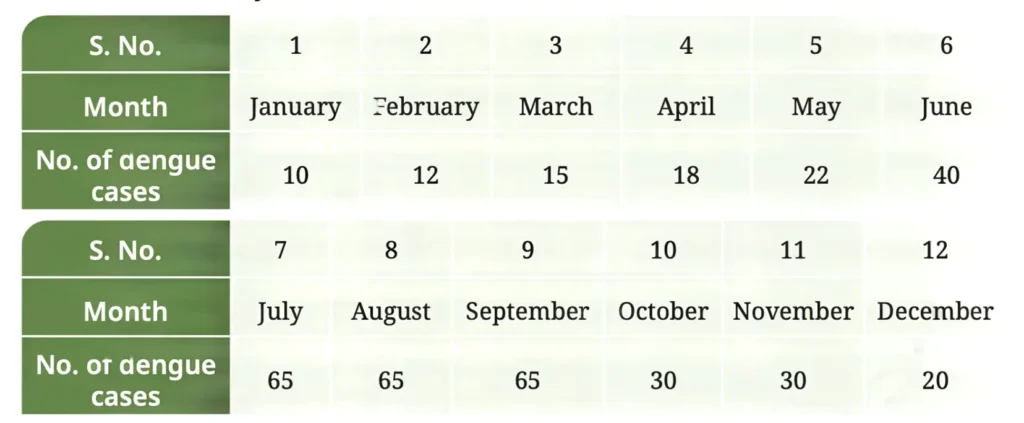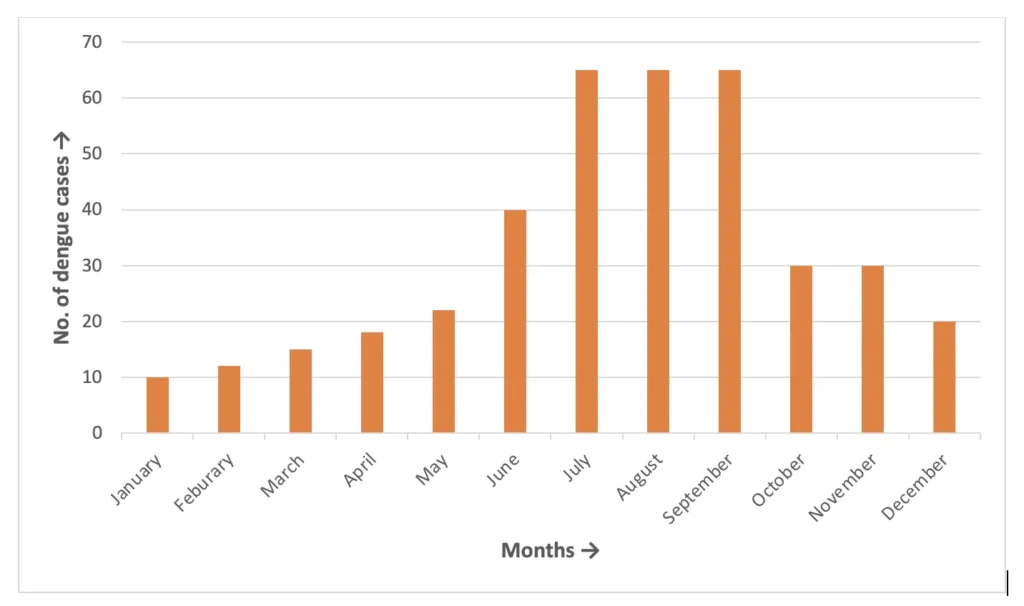Class 8 Science Curiosity Chapter 3 Health: The Ultimate Treasure NCERT Solutions
Textbook Page 42 – 45
1. Group the diseases shown in the images as communicable or non-communicable.

Answer:
Communicable diseases: Diabetes and Asthma.
Non-communicable disease: Cold and flu, Typhoid, and Chickenpox.
2. Diseases can be broadly grouped into communicable and non-communicable diseases. From the options given below, identify the non-communicable diseases.
(i) Typhoid (ii) Asthma (iii) Diabetes (iv) Measles
(a) (i) and (ii)
(b) (ii) and (iii)
(c) (i) and (iv)
(d) (ii) and (iv)
Answer:
(b) (ii) and (iii)
Asthma and Diabetes.
3. There is a flu outbreak in your school. Several classmates are absent, while some are still coming to school coughing and sneezing.
(i) What immediate actions should the school take to prevent further spread?
Answer:
• Advise sick students to stay at home until they recover.
• Inform parents about the flu outbreak and its preventive measures.
• Ensure classrooms are well-ventilated.
• Arrange for proper cleaning and disinfection of the classrooms at regular intervals.
• Encourage students to use sanitizers and wear masks
(ii) If your classmate, who shares the bench with you, starts showing symptoms of the flu, how can you respond in a considerate way without being rude or hurtful?
Answer:
• Politely suggest them to inform the teacher.
• Offer tissues or a handkerchief for covering coughs and sneezes.
• Avoid close contact while still showing concern for their well-being.
(iii) How can you protect yourself and others from getting infected in this situation?
Answer:
• Wash hands frequently with soap and water or use hand sanitizer.
• Avoid touching your face, especially eyes, nose, and mouth.
• Keep a safe distance from people who are coughing or sneezing.
• Wear a mask, especially in crowded areas.
• Maintain good personal hygiene and a healthy diet to boost immunity.
4. Your family is planning to travel to another city where malaria is prevalent.
(i) What precautions should you take before, during, and after the trip?
Answer:
Before travelling to a malaria-prone area, travellers should consult a doctor for preventive medication and carry mosquito nets, repellents, and full-sleeved clothing. During the trip, they should use mosquito nets while sleeping, apply repellents, wear protective clothing, and avoid going out after dusk. After the trip, they should watch for symptoms such as fever, body aches, or chills, and take proper medication if needed.
(ii) How can you explain the importance of mosquito nets or repellents to your sibling?
Answer:
The importance of mosquito nets or repellents can be explained to siblings by telling them that these serve as a protective barrier against mosquitoes, preventing bites and the spread of malaria.
(iii) What could happen if travellers ignore health advisories in such areas?
Answer:
Ignoring health advisories can cause serious illness, hospitalisation, and even the spread of disease to multiple other persons.
5. Your uncle has started smoking just to fit in with his friends, even though it is well known that smoking can seriously harm health and even cause death.
(i) What would you say to him to make him stop, without being rude?
Answer:
I would politely remind him that smoking can cause serious health problems such as cancer, heart disease, and breathing difficulties. I would suggest healthier stress-relief options, like sports or hobbies, and encourage him to spend time with friends who support healthy habits.
(ii) What would you do if your friend offers you a cigarette at a party?
Answer:
I would firmly but politely say, “No, I don’t smoke.” I would then try to change the topic or walk away if pressured.
(iii) How can schools help prevent students from indulging in such harmful habits?
Answer:
School can prevent students from indulging in such harmful habits by:
1. Organizing awareness programs about the ill effects of smoking and tobacco.
2. Inviting doctors to share their experiences.
3. Promoting sports, arts, and clubs to engage students in healthy activities.
6. Saniya claims to her friend Vinita that “Antibiotics can cure any infection, so we don’t need to worry about diseases.” What question(s) can Vinita ask her to help Saniya understand that her statement is incorrect?
Answer:
Vinita can ask questions such as:
Do antibiotics work against viral infections like the common cold or flu?
Do you know that some diseases are caused by viruses, fungi, or protozoa that antibiotics cannot cure?
Have you heard that overuse of antibiotics can make bacteria resistant to them?
These questions can help Saniya realise that antibiotics are effective only against bacterial infections and not all diseases.
7. The following table contains information about the number of dengue cases reported in a hospital over a period of one year:

Make a bar graph of the number of cases on the Y-axis and the month on the X-axis. Critically analyse your findings and answer the following:
(i) In which three months were the dengue cases highest?
(ii) In which month(s) were the cases lowest?
(iii) What natural or environmental factors during the peak months might contribute to the increase in dengue cases?
(iv) Suggest a few preventive steps that the community or government can take before the peak season to reduce the spread of dengue.
Answer:

(i) The three months with the highest number of dengue cases are July, August, and September (65 cases each).
(ii) The month with the lowest number of cases is January (10 cases).
(iii) Natural or environmental factors contributing to the increase in dengue cases during peak months:
1. Heavy rainfall causes water stagnation, which provides breeding grounds for mosquitoes.
2. A warm and humid climate favours mosquito survival and reproduction.
3. Increased outdoor activities during these months lead to more exposure to mosquitoes.
(iv) Preventive steps before the peak season:
1. Eliminate stagnant water from containers, tyres, coolers, and open drains.
2. Conduct regular fogging and spraying of insecticides in mosquito-prone areas.
3. Encourage the use of mosquito nets, repellents, and protective clothing.
4. Launch public awareness campaigns about dengue prevention and early detection.
8. Imagine you are in charge of a school health campaign. What key messages would you use to reduce communicable and non-communicable diseases?
Answer:
For reducing communicable diseases:
(i) Wash hands regularly with soap and water.
(ii) Cover your mouth and nose while sneezing and coughing.
(iii) Keep your surroundings neat and clean to prevent mosquito and pest breeding.
(iv) Avoid sharing personal items like towels, handkerchiefs and water bottles.
For reducing non-communicable diseases:
(i) Eat a balanced diet with plenty of fruits, vegetables, and whole grains.
(ii) Exercise regularly and stay physically active.
(iii) Manage stress through hobbies, sports, or relaxation techniques.
(iv) Avoid tobacco, alcohol, and junk food.
9. It is recommended that we should not take an antibiotic for a viral infection like a cold, a cough, or flu. Can you provide the possible reason for this recommendation?
Answer:
Antibiotics are medicines that kill or stop the growth of bacteria. Cold, cough, and flu are caused by viruses, not bacteria. So, antibiotics do not work on these illnesses. If taken unnecessarily, they can kill the helpful bacteria in our body and make some harmful bacteria resistant to antibiotics. This can make antibiotics less effective in the future.
10. Which disease(s) among the following may spread if drinking water gets contaminated by the excreta from an infected person? Hepatitis A, Tuberculosis, Poliomyelitis, Cholera, Chickenpox.
Answer:
If drinking water is contaminated by the excreta of an infected person, the diseases that may spread are Hepatitis A, Poliomyelitis, and Cholera.
These diseases are caused by pathogens that can survive in contaminated water and infect people when the water is consumed.
11. When our body encounters a pathogen for the first time, the immune response is generally low, but on exposure to the same pathogen again, the immune response by the body is much more compared to the first exposure. Why is it so?
Answer:
When our body encounters a pathogen for the first time, it produces a primary immune response, which is usually slow and weak. During this process, the immune system develops a memory of the pathogen. When the same pathogen enters the body again, the immune system quickly recognizes it and produces a stronger and faster secondary immune response.
